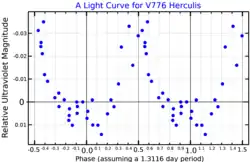| Observation data Epoch J2000 Equinox J2000 | |
|---|---|
| Constellation | Hercules |
| Right ascension | 16h 47m 46.41942s[2] |
| Declination | +05° 14′ 48.2789″[2] |
| Apparent magnitude (V) | 5.22[3] |
| Characteristics | |
| Spectral type | A1 Vp Si[4] or B9p Cr[5] |
| U−B color index | +0.005[6] |
| B−V color index | −0.025[6] |
| Variable type | α2 CVn[7] |
| Astrometry | |
| Radial velocity (Rv) | −16.1±2[8] km/s |
| Proper motion (μ) | RA: −18.802[2] mas/yr Dec.: −38.735[2] mas/yr |
| Parallax (π) | 8.1955 ± 0.2169 mas[2] |
| Distance | 400 ± 10 ly (122 ± 3 pc) |
| Absolute magnitude (MV) | −0.18[9] |
| Details | |
| Mass | 2.85±0.11[10] M☉ |
| Radius | 4.86[11] R☉ |
| Luminosity | 120.06[9] L☉ |
| Surface gravity (log g) | 3.00[12] cgs |
| Temperature | 9,333[12] K |
| Metallicity [Fe/H] | 0.10[12] dex |
| Rotational velocity (v sin i) | 44[13] km/s |
| Other designations | |
| Database references | |
| SIMBAD | data |
45 Herculis is a solitary[15] variable star in the northern constellation Hercules. It has the Bayer designation l Herculis and the variable star designation V776 Herculis. The Flamsteed designation for this star comes from the publication Historia Coelestis Britannica by John Flamsteed. It is the 45th star in Flamsteed list of stars in the constellation Hercules, and is visible to the naked eye with a baseline apparent visual magnitude of 5.22.[3] Parallax measurements show this star to be about 400 light-years away from the Solar System.[2] It is moving closer to the Earth with a heliocentric radial velocity of −16 km/s.[8]
Cowley et at. (1969) assigned this object a classification of B9p Cr,[5] while Abt and Morrell (1995) found a class of A1 Vp Si.[4] Both indicate this is a late B- or early A-type chemically peculiar, or Ap star, with abundance anomalies in chromium or silicon. It is an Alpha2 Canum Venaticorum variable that ranges in visual magnitude from 5.21 down to 5.27.[7] The star has 2.9[10] times the mass of the Sun and 4.9[11] times the Sun's radius. It is radiating 120[9] times the Sun's luminosity from its photosphere at an effective temperature of 9,333 K.[12]
References
- ↑ Burke, E. W. Jr.; Barr, T. H. (June 1981). "Photometric UBV period study of eight AP stars". Publications of the Astronomy Society of the Pacific. 93: 344–350. Bibcode:1981PASP...93..344B. doi:10.1086/130836. S2CID 122946991. Retrieved 10 January 2022.
- 1 2 3 4 5 6 Brown, A. G. A.; et al. (Gaia collaboration) (August 2018). "Gaia Data Release 2: Summary of the contents and survey properties". Astronomy & Astrophysics. 616. A1. arXiv:1804.09365. Bibcode:2018A&A...616A...1G. doi:10.1051/0004-6361/201833051. Gaia DR2 record for this source at VizieR.
- 1 2 Ducati, J. R. (2002). "VizieR Online Data Catalog: Catalogue of Stellar Photometry in Johnson's 11-color system". CDS/ADC Collection of Electronic Catalogues. 2237. Bibcode:2002yCat.2237....0D.
- 1 2 Abt, Helmut A.; Morrell, Nidia I. (1995). "The Relation between Rotational Velocities and Spectral Peculiarities among A-Type Stars". Astrophysical Journal Supplement. 99: 135. Bibcode:1995ApJS...99..135A. doi:10.1086/192182.
- 1 2 Cowley, A.; et al. (April 1969). "A study of the bright A stars. I. A catalogue of spectral classifications". Astronomical Journal. 74: 375–406. Bibcode:1969AJ.....74..375C. doi:10.1086/110819.
- 1 2 Mermilliod, J.-C. (1986). "Compilation of Eggen's UBV data, transformed to UBV (unpublished)". Catalogue of Eggen's UBV Data. Bibcode:1986EgUBV........0M.
- 1 2 Samus, N. N.; et al. (2017). "General Catalogue of Variable Stars". Astronomy Reports. 5.1. 61 (1): 80–88. Bibcode:2017ARep...61...80S. doi:10.1134/S1063772917010085. S2CID 125853869.
- 1 2 Wilson, Ralph Elmer (1953). "General catalogue of stellar radial velocities". Carnegie Institute Washington D.C. Publication. Bibcode:1953GCRV..C......0W.
- 1 2 3 Anderson, E.; Francis, Ch. (2012). "XHIP: An extended hipparcos compilation". Astronomy Letters. 38 (5): 331. arXiv:1108.4971. Bibcode:2012AstL...38..331A. doi:10.1134/S1063773712050015. S2CID 119257644.
- 1 2 Netopil, Martin; Paunzen, Ernst; Huemmerich, Stefan; Bernhard, Klaus (July 2017). "An Investigation of the Rotational Properties of Magnetic Chemically Peculiar Stars". Monthly Notices of the Royal Astronomical Society. 468 (3): 2745–2756. arXiv:1703.05218. Bibcode:2017MNRAS.468.2745N. doi:10.1093/mnras/stx674. S2CID 119215348.
- 1 2 Shulyak, D.; et al. (2014). "Interferometry of chemically peculiar stars: Theoretical predictions versus modern observing facilities". Monthly Notices of the Royal Astronomical Society. 443 (2): 1629. arXiv:1406.6093. Bibcode:2014MNRAS.443.1629S. doi:10.1093/mnras/stu1259. S2CID 96452769.
- 1 2 3 4 Wolff, Sidney Carne (October 1967). "A Spectroscopic and Photometric Study of the AP Stars". Astrophysical Journal Supplement. 15: 21. Bibcode:1967ApJS...15...21W. doi:10.1086/190162.
- ↑ Royer, F.; et al. (October 2002). "Rotational velocities of A-type stars in the northern hemisphere. II. Measurement of v sin i". Astronomy and Astrophysics. 393: 897–911. arXiv:astro-ph/0205255. Bibcode:2002A&A...393..897R. doi:10.1051/0004-6361:20020943. S2CID 14070763.
- ↑ "45 Her". SIMBAD. Centre de données astronomiques de Strasbourg. Retrieved 2019-06-14.
- ↑ Eggleton, P. P.; Tokovinin, A. A. (September 2008). "A catalogue of multiplicity among bright stellar systems". Monthly Notices of the Royal Astronomical Society. 389 (2): 869–879. arXiv:0806.2878. Bibcode:2008MNRAS.389..869E. doi:10.1111/j.1365-2966.2008.13596.x. S2CID 14878976.
